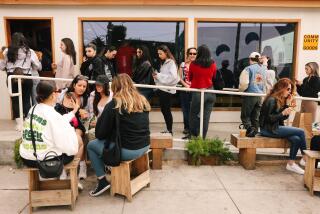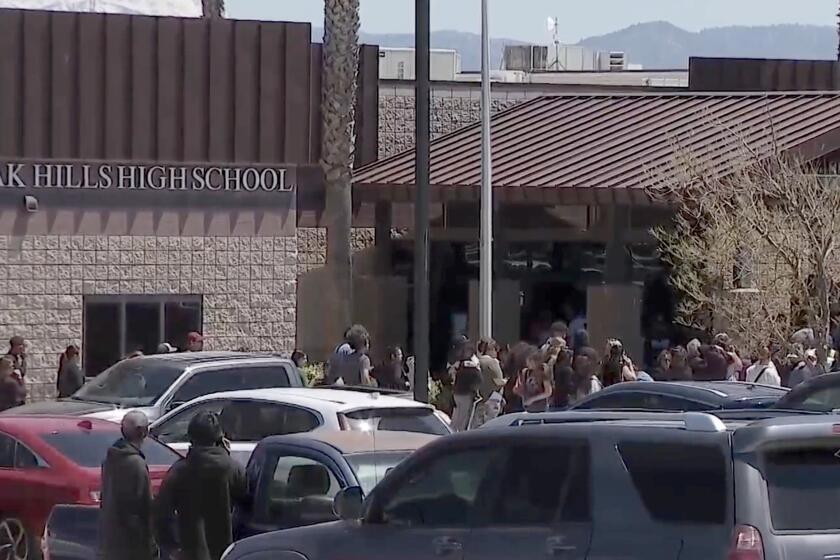Hipsters Send Times Into Tizzies
Less than a month after my wife and I moved to the Los Feliz/Silver Lake area in August 1998, we were alarmed to learn in the L.A. Times that our charming new neighborhood was going straight to the dogs.
“Neighbors Rankled by Closing of Coffee Spot,” a grim Metro section headline warned us. “Loss of La Conversation bakery/java joint after 17 years is compounded by fear of Los Feliz gentrification. Co-owner blames chain competition.”
Had we arrived too late? The world-weary freelance writer, who exuded intimate knowledge of the tiny cafe, sure seemed to think so.
“As they savored their last afternoon at the shop, a band of distraught Felizians sat wondering aloud about where their community was heading .” he emoted.
“It seemed clear that the current running beneath the anger was fear that La Conversation’s demise is another sign that Los Feliz is in danger of falling victim to its own hipness . Co-owner Steve Carson said his shop has lost money for six months, ever since a chain coffee shop opened down the street.”
What was this dreaded “chain coffee shop”? The writer could not bring himself to speak its name (Coffee Bean). Nor did he give a hint as to why any “Felizians” (as I’ve never heard any of us call ourselves) might actually prefer a place where 20 people can sit comfortably in the sunshine.
But we were new to Los Angeles, and had not yet recognized the three favorite sub-categories of L.A. Times gentrification stories — the Chain Store Lament, the Requiem for a Neighborhood Ruined by Hipsters and the Eternal Search for the Next Los Feliz (or Silver Lake, or Echo Park).
These articles bear the usual flaws of Spring Street feature writing — treacly melodrama, the aforementioned unwillingness to name names (non-gentrification example: a September 2004 article about kayaking on Reno’s Truckee River that kept referencing “one study” and “an economist” without mentioning, um, which ones); and an absence of follow-up to the gloomy forecasts.
For instance, Ala Mazloumian, who helped run La Conversation, was portrayed in the obit as a prospect-less soul with “red-rimmed eyes.” In fact, Mazloumian did all right by herself — she now manages the perfectly great little Cafe Los Feliz in the exact same spot. And the neighborhood has managed to muddle through despite this change.
Besides fixating on the minority of Southern California neighborhoods where “artists and writers” hang out, The Times’ gentrification stories also tend to display an unseemly condescension toward the consumption habits of others.
“The whole economy is based on people shopping, shopping, shopping, whether they need anything or not,” columnist (and Silver Lake resident) Steve Lopez sneered in a November 2003 jeremiad against his nearby Costco, which itself has been the target of several Times articles along the lines of “Atwater Divided Over Shopping Center; Some say the ‘big box’ stores have hurt the area. Others welcome the added revenue.”
You don’t even have to be a hated retail chain such as Costco or Wal-Mart — subject of a straight-to-the-Pulitzers series in November 2003 — to warrant a preemptive wringing of the hands.
Hollywood’s fantastic Amoeba Music, true friend to artists and writers everywhere, was welcomed to L.A. in November 2001 by a nearly suicidal 1,800-word thumb-sucker by staff writer Susan Carpenter. “Most L.A. indie sellers,” Carpenter intoned, “had been eyeing the transplant with a mixture of curiosity and dread. Already struggling in a down market, they can only hope Amoeba doesn’t cut the pie into such small slivers that they are driven out of business.” (Aron’s Records still seems to be thriving, Susan.)
Carpenter lives in Eagle Rock (“the latest ‘it’ neighborhood,” she helpfully pointed out last June), which was memorialized in a July 2001 L.A. Times Magazine cover story as “the next Los Feliz.”
Neighboring Highland Park, meanwhile, is having its “gritty authenticity” challenged by the influx of “younger artists, musicians and first-time home buyers priced out of Silver Lake and Echo Park,” according to a Jan. 24 article. That same day, another article lamented the “forcing out” of “low-income working families and young bohemians” from Echo Park. Three years earlier, these same migratory “artsy types” from my ‘hood were also blamed for forcing out an unspecified number of “low-income residents” from Koreatown. Have these hipsters no shame, at long last?
Gentrification anxiety is a real phenomenon (as is gentrification hope) and deserves reporting, but there are infinitely more variations on the theme in this famously diverse city than white-Silver-Lake-bohos-invade-working-class-’hood. Wal-Mart and even the unmentionable Coffee Bean may indeed alter the flavor and economy of neighborhoods, but not one-dimensionally for the worse. Consumption is not evil, and there are many other communities worth covering besides the ones where Times staffers live.
As for the next Los Feliz? I nominate Los Feliz.
More to Read
Start your day right
Sign up for Essential California for news, features and recommendations from the L.A. Times and beyond in your inbox six days a week.
You may occasionally receive promotional content from the Los Angeles Times.






